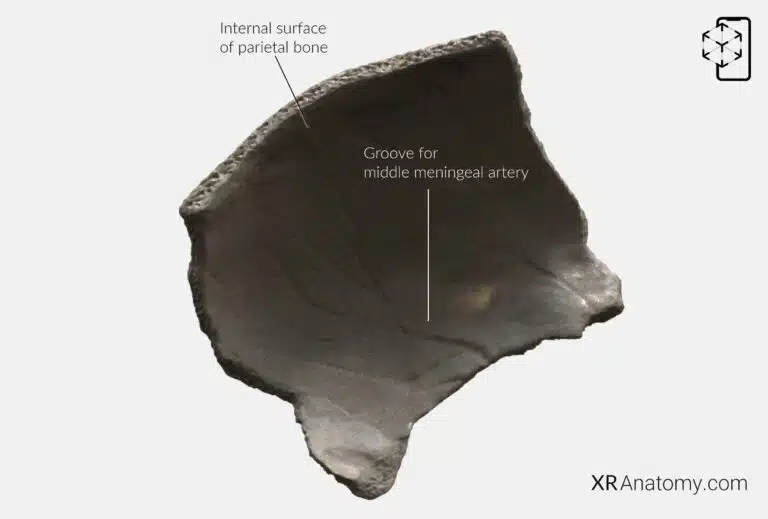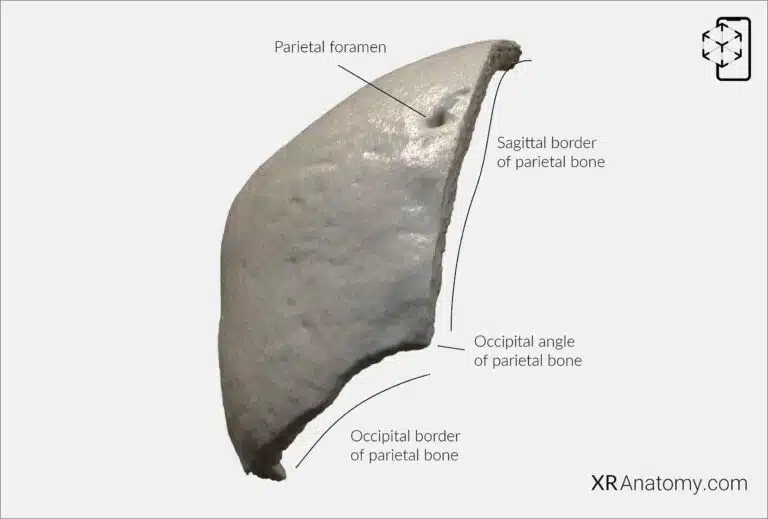PARIETAL BONE
Interactive 3D Version Available
Explore this anatomy in full 360° rotation with our interactive 3D viewer
View in 3D →PARIETAL BONE AR ATLAS

The parietal bones are a pair of flat bones located on the superolateral aspect of the cranium. They form a significant portion of the sides and roof of the skull, contributing to the overall shape and protection of the brain. the frontal bone anteriorly, the occipital bone posteriorly, the temporal bone inferiorly, and its fellow parietal bone medially at the sagittal suture.
INTERNAL SURFACE OF THE PARIETAL BONE

The is marked by grooves and depressions that accommodate structures of the brain and its protective membranes. One of the most prominent features is the , a channel that allows this vital artery to traverse the inner surface of the bone. The middle meningeal artery supplies blood to the dura mater, the outermost layer of the meninges covering the brain. The internal surface also shows impressions from the arachnoid granulations and cerebral gyri.
THE EXTERNAL SURFACE OF THE PARIETAL BONE

The is smooth and convex, forming part of the scalp's underlying structure. Notable features include the and —two curved ridges that arch across the bone's surface. The serves as the attachment point for the temporal fascia, while the provides attachment for the temporalis muscle, a key muscle involved in mastication.
The , or parietal tuber, is a prominent convex area near the center of the bone. This area contributes to the rounded contour of the skull.
Bordering the parietal bone are several important sutures and articulations. The articulates with the occipital bone at the lambdoid suture. The , or inferior border, articulates anteriorly with the greater wing of the sphenoid bone, centrally with the squamous portion of the temporal bone, and posteriorly with the mastoid portion of the temporal bone. The is the longest and connects with the opposite parietal bone along the sagittal suture. The articulates with the frontal bone at the coronal suture.
Each parietal bone has four angles corresponding to the points where the borders meet. The is located where the sagittal and coronal sutures intersect. The , is at the junction of the sagittal and lambdoid sutures. The is found where the bone meets the frontal bone and the greater wing of the sphenoid bone. The is situated where the parietal bone articulates with the occipital bone and the mastoid portion of the temporal bone.
The is a small opening near the sagittal border, variable in size, which allows passage for an emissary vein.
BIBLIOGRAPHY
1. Henry G, Warren HL. Osteology. In: Anatomy of the Human Body. 20th ed. Philadelphia: Lea & Febiger; 1918. p. 129–97.
2. Sampson HW, Montgomery JL, Henryson GL. Atlas of the human skull. College Station: Texas A & M University Press; 2007.
4. Saylam C, Özer MA, Ozek C, Gurler T. Anatomical Variations of the Frontal and Supraorbital Transcranial Passages. Journal of Craniofacial Surgery. 2003;14(1):10–2.
5. Hosemann W, Gross R, Goede U, Kuehnel T. Clinical anatomy of the nasal process of the frontal bone (spina nasalis interna). Otolaryngology – Head and Neck Surgery. 2001;125(1):60–5.
6. Steele DG, Bramblett CA. The anatomy and biology of human skeleton. Texas A&M University Press; 1988.
7. Tersigni-Tarrant MTA, Shirley NR. Human osteology. Vol. 4, Forensic Anthropology: An Introduction. 2012. 33–68 p.
8. Monjas-Cánovas I, García-Garrigós E, Arenas-Jiménez JJ, Abarca-Olivas J, Sánchez-Del Campo F, Gras-Albert JR. Radiological Anatomy of the Ethmoidal Arteries: CT Cadaver Study. Acta Otorrinolaringologica (English Edition). 2011;62(5):367–74.
9. Pereira G, Lopes P, Santos A, Krebs. Morphometric aspects of the jugular foramen in dry skulls of adult individuals in Southern Brazil. Vol. 27, J. Morphol. Sci. 2010.
12. Kunc V, Fabik J, Kubickova B, Kachlik D. Vermian fossa or median occipital fossa revisited: Prevalence and clinical anatomy. Annals of Anatomy. 2020 May 1;229:151458.
14. Standring S. The skull. In: Gray’s anatomy: the anatomical basis of clinical practice. 2021st ed. Elsevier Health Sciences; 2021. p. 558–73.
15. Rhoton AL. Chapter 1 Overview of Temporal Bone. Neurosurgery. 2007;
17. Tóth M, Moser G, Patonay L, Oláh I. Development of the anterior chordal canal. Annals of Anatomy. 2006;
18. Carpenter G, Knipe H. Tympanic part of temporal bone. Radiopaedia.org. 2014 Mar 23;
19. Eckerdal O. The petrotympanic fissure: A link connecting the tympanic cavity and the temporomandibular joint. Cranio – Journal of Craniomandibular Practice. 1991;9(1):15–22.
21. Singh R, Kishore Gupta N, Kumar R. Morphometry and Morphology of Foramen Petrosum in Indian Population. Basic Sciences of Medicine. 2020;2020(1):8–9.
23. Piagkou M, Xanthos T, Anagnostopoulou S, Demesticha T, Kotsiomitis E, Piagkos G, et al. Anatomical variation and morphology in the position of the palatine foramina in adult human skulls from Greece. Journal of Cranio-Maxillofacial Surgery. 2012 Oct 1;40(7):e206–10.



